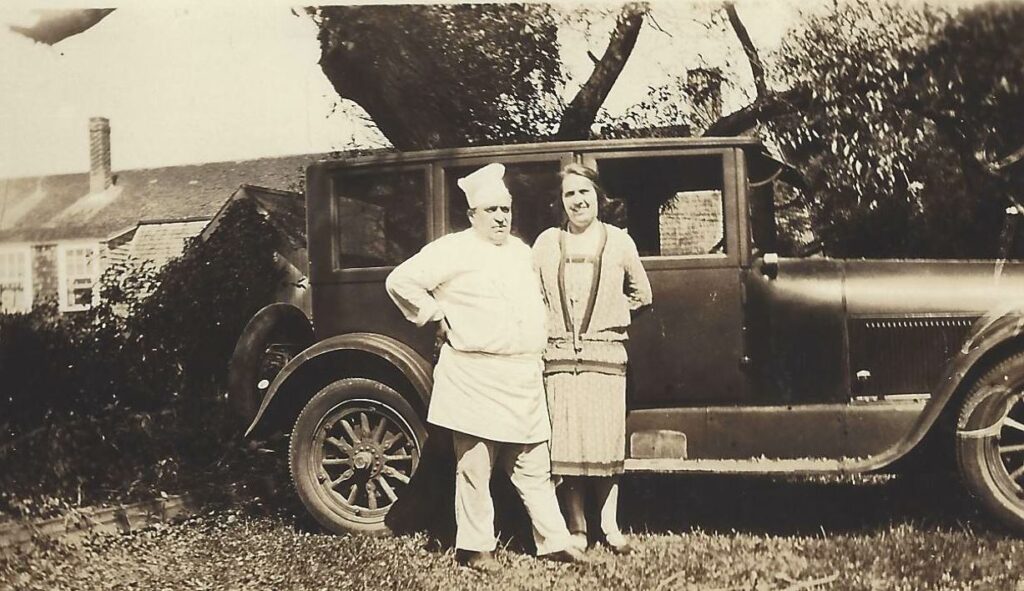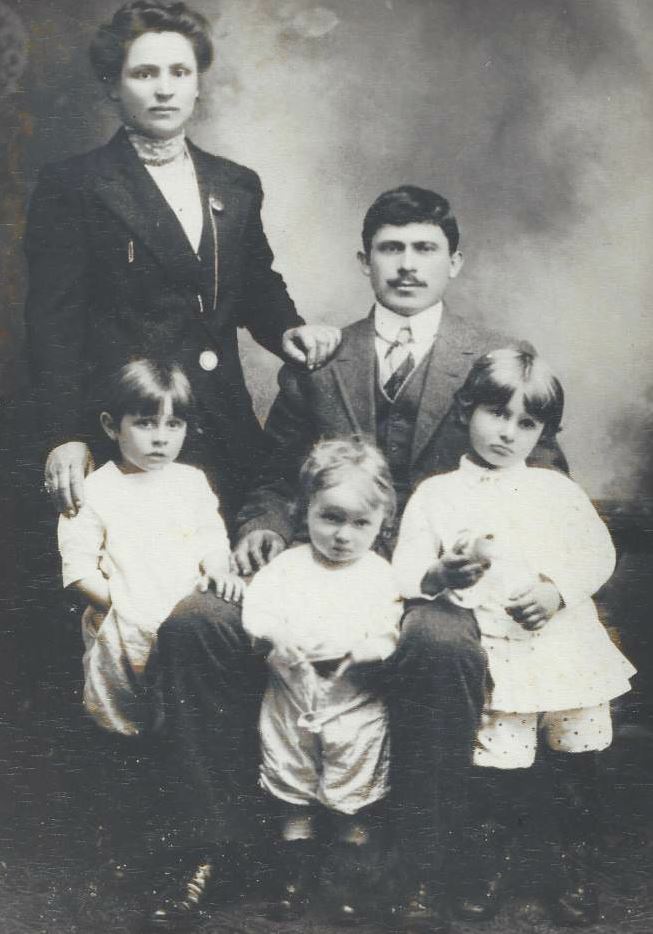19 Dec The food and family of Amelia Dall’Olio and Giovanni Cevolani
The food and family of Amelia Dall’Olio and Giovanni Cevolani
Amelia Dall’Olio, my maternal grandmother was born in Renazzo di Cento on 25 September 1890.
In 1911 she left her family in Castello d’Argile and boarded the Canopic in Genoa and arrived in Massachusetts at the Port of Boston on November 5th that same year. She was 21 years old. There to meet her was my grandfather, Giovanni Cevolani. Born on 24 June 1896, he was 25 years old.

The Cevolani family in an image from 1907, from top left Anselmo Cevolani (1889-1964), his brother Federico (1884-1969), his brother Giovanni (1896-1968), in the center his parents Antonio Cevolani (1853-1915) and his wife Adelina Accorsi (1857-1914), his sister Esterina (1877-1969) is missing in the photograph
His journey to America had begun a year earlier in 1910 when he left Pieve di Cento and boarded the Duca di Genova arriving at the Port of New York on 25 July 1910.

Giovanni Cevolani, Boston, about 1920
One day after my grandmother’s arrival, they were married at the Sacred Heart Church in Boston’s North End. Also known as Chiesa di Sacre Coeur di Gesu, it was home to Italian immigrants at the turn of the century.
Their marriage certificate states: il signor Giovanni Cevolani di Pieve di Cento, Ferrara, figlio di Antonio e di Adele Accorsi e di la signora Amelia Dall’Olio da Renazzo di Cento, Ferrara, figlia di Alessandro e di Elena Tassinari. Alla presenza di Ettore Tassinari e Luisa Ardolino.
Ettore was the uncle of Amelia, and the first in the family to immigrate to America arriving in about 1860.
Giovanni and Amelia settled into a little, wooden house in Danvers, Massachusetts likely owned by Ettore who was known for his generosity and helping relatives and paesani. My grandmother cried when she first saw her new home. It was small and nothing like the home she had left behind or the one she had dreamed of finding in America. Giovanni was determined to have his own home. He never wanted to be beholden to anybody, so as soon as Giovanni and Amelia, found work and became more established, they moved to Somerville, Massachusetts. Early documents list their occupations as cook and seamstress. They were talented and skilled and soon they became well known for their work.

Giovanni and Amelia
On 7 May 1916 my mother, Elena Adele Cevolani their only child was born. My grandfather, as the story goes, on the day she was baptized, hired a harpist to play on their front porch. Is this true? Hard to know, but I do know that my Nonno was larger than life.

Elena and the cousin Renato Magri. Photo taken in Italy in Castello d’Argile in 1925 on the occasion of a visit to the Cevolani relatives
Giovanni and Amelia continued the tradition of helping paesani. Their house at 50 Lowell Street was a two-family big enough so that relatives who came from Italy could stay. And did stay there for a month or a year or two years. My mother, Elena, described life there:
Domenico Tassinari and his wife Erminia, lived in a very tiny apartment on the first floor, so they spent a lot of time upstairs with us. They used to eat at our table too because my father was a cook and always came home with a lot of food. My mother sewed so Erminia did most of the housework. She was awfully good about that. And, when her husband came home from work, he’d come upstairs and it was that kind of a household. And because the apartment was so small and because the families shared so many relatives and friends, whenever people came to the house to visit, everyone would congregate in my parents’ home. It was always a household full of people and fun.

Last row, from left to right, Teresa Diotoita a friend, Teresa Zamprogno, aunt of Joan Benotti, Bianca Canettoli Benotti, grandmother of Joan Benotti, Amelia Dall’Olio Cevolani, Elena Cevolani Benotti. In the front row from the left, Francesca Racioppi, Joan’s aunt and Augusta Racioppi
My mother Elena graduated with honors from Somerville High School in 1933. In 1937 she graduated from Radcliffe College with a concentration in chemistry. A year later she traveled with her mother to Renazzo.

Passport of Amelia Dall’Olio, 1937
When she returned she worked as a Social Worker for the Division of the Blind until her wedding. She married her childhood friend Alfred Benotti on 7 November 1942, thirty years and one day after her parents’ wedding.

Wedding photo of Alfred and Elena, dress made by Amelia
Their marriage certificate lists their occupations as Mechanical Engineer and Social Worker. I still have the wedding dress her mother Amelia made for her that day 78 years ago.
My father, Alfred Benotti was born on the Renwick Estate in Weston, Massachusetts, 9 September 1912. His parents, Raffaele and Bianca Canettoli Benotti tended gardens, animals, vehicles and children on the estate.

Benotti Family
My father had two brothers – one older one younger – Joseph and Norbert, and a sister, Theresa, the youngest.
They all graduated from university his brothers in chemistry, Theresa with honors in Italian, and Alfred with a degree in Mechanical Engineering. After graduation he worked at the Boston Naval Yard inspecting and repairing submarine engines during the war.
My grandfather, Giovanni Cevolani, became a Naturalized Citizen in 1940 and bought the house on 24 Maugus Avenue in Wellesley Hills, Massachusetts.

Grandfather John’s home in Wellesley
I was born on Palm Sunday 10 April 1949. I joined my grandparents, my parents and my brother John at that house in Wellesley Hills. John was three years older, born 1 August 1946.

Amelia Dall’Olio Cevolani with her nephew John, 1947
The Benotti and Cevolani families were always close sharing meals on weekends and every holiday. My mother called her brothers-in-law The Benotti Boys. My generation continued this tradition. My world, our world revolved around family and food.
The enjoyment of creating and eating was an essential ingredient to our family life.
Once a week Nana Amelia, also known for her cooking, would make pasta. I loved to watch her roll the wide sheets of pasta dough by hand with her long wooden rolling pin, her strong arms and hands knowing every gesture.

Cevolani and Benotti families
Before the holidays we all would gather around the kitchen table to help make filled pasta, ravioli and tortellini. My little fingers loved this shape making and eating – especially the tortellini! Press it tight – my father would say – so that when they were put into the simmering brodo they didn’t fall apart.
Nana also made chicken and beef broth every week, and of course Pasta e Faggioli every Friday. They taught me well. I still make Bolognese pasta verde al forno every Christmas. And I in turn have taught my cousins.
While my grandparents still lived in Somerville they began working summers in Magnolia, Massachusetts, a seaside town just north of Boston. Giovanni first found work at nearby Salem’s “Hawthorn Hotel” and later was chef at Sadie Kelley’s Green Gables a dining, dancing and jazz establishment in Magnolia. Or- as my mother used to say – He came to work in the swanky nightclubs in Magnolia.

The Green Gables Club of Magnolia
And swanky it was. The area was known as the Gold Coast. The Boston train would arrive and wealthy Bostonians and summering diplomats would be ferried to the 600-bed grand Oceanside Hotel with its exclusive shopping arcade. My grandfather cooked and my grandmother sewed.
In 1941 they bought a small cottage near the Hotel, on Ocean Avenue but not too near the rocky shores that line the coast. As the story goes, Nana had put her foot down. “Too risky,” she said. The house sits on a corner just far enough from the sea and surrounded by a tall hedge. Now the house in Magnolia is my home and studio.
My brother and I were fortunate to summer in Magnolia and in the fall return to Wellesley for school.

Amelia and Giovanni Cevolani with their grandchildren John and Joan, summer 1953
The Wellesley house was large. On the second floor, in my grandparents’ dusty rose bedroom, my Nana’s favorite color, was where she sewed. Theirs was the largest bedroom with a private bath and a walk-in cedar closet filled with bolts of richly colored velvets, brocades and shiny moirés. It was a magical place. Sometimes I would sneak in just to open the door to breath in the scent of cedar and look up at all the colors on shelves high above my head. On sunny afternoons I was allowed to visit if I sat still and quiet. She taught me to make a rolled hem. I still remember how.
Nana sewed long, deep rose velvet drapes for the living room and thickly lined, deep green moiré ones with a bedspread that matched for my parents’ room. She covered the house. I loved helping my mother make that bed as the fabric shimmered with every touch. And it took two of us to lift it! More than making drapes and bedspreads for her many clients in Wellesley and Boston, she sewed beautiful clothes for me from cast-off lengths of fancy fabrics. I wore a rich blue velvet coat with leggings and cap to match when I was 3 to visit Santa Claus who had flown into Wellesley by helicopter.
My picture was in the local newspaper.

My photograph in the local Santa Express newspaper
Nana cooked and sewed. I watched. Her creativity and passion inspired me to pursue what I loved.
I became a painter. My work integrates story and memory with pattern and place. It is cut, patched, sewn, painted, beaded, gilded, altered and remade. A photo of my Nana sits on my table as I work. She is my muse.

Nana on my table
I was almost 10 years old when my Nana Amelia died suddenly on 23 January 1959 while on vacation with my grandfather, Giovanni, in Hollywood, Florida.
Nonno never really recovered from the grief and the loss of his wife and beloved partner.
He was drawn to go back to Italy, to go back home. My mother recalled that he returned often to Renazzo and loved it there.
I remember going to Boston’s Logan airport to wave goodbye.
The Alitalia crew would wheel him like a King to the plane. My father would chuckle as my mother would watch mortified hoping that no one would discover the salamis he was hiding under his coat as gifts for those in Renazzo.

Alfred and Elena Benotti, Christmas 1968
He would visit Amelia’s relatives still living in the family’s ancestral home.
Today they recall his month-long stays with them and his love of cooking.
He died on 4 December 1968 while visiting with his family in Argelato, a commune in the District of Bologna.
Generously, Amelia’s relatives drove back and forth to Florence, back and forth several times a 4-hour roundtrip drive–to complete the necessary paperwork to ensure his body was returned home to America.
But before that are memories of indulgence, abundance and love.
Rides in his shiny new Cadillac, a trip to the racetrack, hours spent trying to avoid the smell from his Parodi cigars, lit or not as I sat on the arm of his big leather chair.
A case of green grapes, a bunch was not enough for my brother who at 4 or 5 had mentioned that he liked them.
At that time in Wellesley there was only one other Italian family with children in school. Wellesley was stuffy, wealthy, Irish and Yankee.
My grandfather was not any of these things.
During Catechism classes the nuns had made it abundantly clear that it was necessary to attend Mass at least once a year during Easter Week. My grandfather never went to church. I remember asking him, I was probably 13, if he would come with us this year. He looked up at me from his large leather chair and sai: little one, I kneel for nobody.
He was as my mother often said, his own man.

The Chef Giovanni Cevolani
During the 1940s and 1950s he owned an Italian grocery and package store in Boston’s North End, “A. Cevolani, Inc.”
My brother John remembered stocking shelves in the store on Saturday afternoons. I remember being perched on the counter my feet far from the floor while Nonno made a cold cut sandwich that was twice as long as I was tall.
Once I followed my Nonno and my father into the basement and watched spellbound as they stuffed sausages and cotechini.
He also owned the restaurant “Cantina Italiana” around the corner on Hanover Street.
During the war, my father told us, he would feed those in need from the back of the restaurant. The Cantina is still in business today. The grocery store, though, was demolished in the 1960s to make way for the new Government Center in Boston.

Giovanni in the Cantina Italiana
Giovanni had learned his craft well those early years in America, by apprenticing at Boston’s big hotels, and eventually becoming the head chef at the Hotel Lucerne. But thankfully he never forgot or dismissed the great Northern Italian food he grew up eating.
An unexpected after-school treat for me, was coming home to the intoxicating aroma of an enormous pot of Bolognese meat sauce simmering on the back of the stove. My friends loved to stop by for a ladleful of this rich, meaty sauce poured over a slice of American white bread—a taste of cultural assimilation. But for dinner my father’s Bolognese 4-corner bread was always on the table. The language often spoken at home among the adults was dialect, Bolognese dialect. It was our parents’ “secret” language which my brother and I learned just enough to know what they were talking about.

My parents Elena and Alfred Benotti
The more that I write about my grandparents the more that I think about the qualities and characteristics they shared with all the others who left family and friends to begin an uncertain yet hope-filled journey to America. Amelia Dall’Olio more cautious, Giovanni Cevolani more impulsive.

Amelia and Giovanni Cevolani
Together they were strong, creative, disciplined, loving and hard working. I am immensely grateful.
by JOAN BENOTTI, granddaughter
Sources:
_ Interview of Elena Cevolani Benotti by Laura M. Alberghini Ventimiglia, a cousin
_ Italian documents
_ Online articles
_ Personal communications with the author’s mother, Elena Cevolani Benotti, and other family members
_ Personal experiences of the author growing up with her grandparents, Amelia Dall’Olio and Giovanni Cevolani
_ United States documents.

